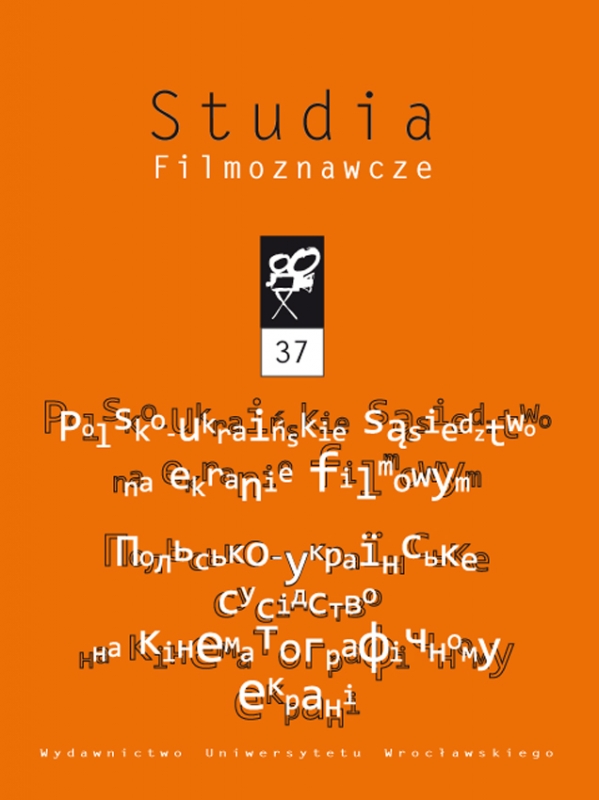

Artykuły [257]

UKRAINIAN THEMES IN POLISH CINEMA UNTIL 1989
In postwar Poland three films were created that alluded directly to the fights of the Polish Communistic Army against the Ukrainian Uprising Army and the Polish Home Army, which took place in Bieszczady at the end of the Second War and in the following several months. These were: Sergeant Major Kaleń Ewa and Czesław Petelscy, 1961, The Ruptured Bridge Jerzy Passendorfer, 1962, Woolves’ Echos Aleksander Ścibor-Rylski, 1968. They were all made to create the myth of Bieszczady, to achieve a propaganda effect. They also all have a form close to that of the western which was a very popular genre in Poland in the time of their making. This form was to make the realization of the mythologizing and propaganda task easier. In Sergeant Major Kaleń the main topic is a military conflict between some troops of the Polish Communistic Army and Ukrainian insurgents just after the end of the Second World War. The movie was an attempt to show the complicated social-political situation of the period in the south-eastern edge of Poland — in Bieszczady. But it was an attempt strongly ideological and dishonest from the point of view of the historical and political truth. The movie has an interesting protagonist, it depicts quite suggestively some human types from Bieszczady of those times, but it is not just in showing “the Ukrainian question” as well as the Polish Home Army and its brave and tragic “cursed soldiers”. Although it should be pointed out that from the historical-political perspective the film is much more honest than the novel by Jan Gerhard Łuny w Bieszczadach [The Glow in Bieszczady] of which it was an adaptation. The Ukrainians and the soldiers of the Polish Home Army in the film by the Petelskis are cruel and ruthless, and only the soldiers of the Communist Polish army are good and honest people. The Ruptured Bridge is also an image touching upon the matter of Polish-Ukrainian struggles just before the end of the Second World War and shortly after that, but it is mainly a splendid film of adventure with some distinctive features of western and criminal-spy-sensational genre. It was based on the short story Śniegi płyną The Snows Are Flowing by Roman Bratny. This is a really good movie that is not as strongly soaked with communistic propaganda as the previous one that does not show the soldiers of UPA Ukrainian Uprising Army as monsters. It is rather universal in its message its epicenter is the beautiful — brave and heroic — attitude of a shire officer who is also an engineer. Similarly to Sergearnt Major Kaleń the literary prototype was much more historically and politically dishonest than its screen adaptation. In Bratny’s short story visible are some postcolonial accents. The Ukrainians are showed as a society culturally retarded, primitive, wild, while Passendorfer’s film seems to suggest that this possible cultural latency of Ukraine was caused by the historical faults of Russia and Poland that in the past had treated Ukraine as their colony. Besides Passendorfer shows this “wildness” of the Ukrainian soldiers in some romantic aura of “Ruthenian falcons”. In turn, Woolves’ Echos is an unpretentious adventure film, lacking political-historical ambitions, successfully shot from its beginning to an end in a western convention. The plot takes place in Bieszczady, a few years after the Second World War. When we measure the gravity of problems separating Poles and Ukrainians after WWII, problems which had never been solved or explored in the Polish People’s Republic, then Woolves’ Echos appears to be compromising for the director, producers and for the Polish People’s Republic’s film authorities of those times. Tadeusz Lubelski once wrote: “The authors [of the movie] did not see to any authentication of the complicated story matters, the most important of which was the real conflict on the Polish-Ukrainian frontier”. Two more movies with clear Ukrainian motives were made in the later years of film development in the Polish People’s Republic. Mr. Wołodyjowski Jerzy Hoffman, 1969 and Mazepa Gustaw Holoubek, 1975. The first one was an adaptation of a novel with the same title, written by Henryk Sienkiewicz. The second movie was a film adaptation of a romantic drama written by Juliusz Słowacki also with the same title. In Sienkiewicz’s novel, the last volume in his trilogy which is very significant for the shape of cultural and historical relations between Poles and Ukrainians, we can find a few very pro-Ukrainian-and-Polish motives e.g. a widely depicted beautiful story of a difficult Polish-Ukrainian relation between Muszalski and Dydiuk — from consuming hatred up to fervent friendship. In Holoubek’s Mazepa, in turn, the pro-Ukrainian/pro-Ruthenian accent is strongly visible. Eponymous Mazepa — in the time of the action of Słowacki’s play and — of course — film, being a pageboy of the Polish King Casimir — is along with the protagonist Zbigniew the most noble and upstanding character in the movie. They are both also the most tragic heroes of the play, personalizing the sacrifice of young people — the Poles and the Ruthenians — that the lordly Poland quite often made in its history to last in its colonial shape.
Translated by Sławomir Bobowski